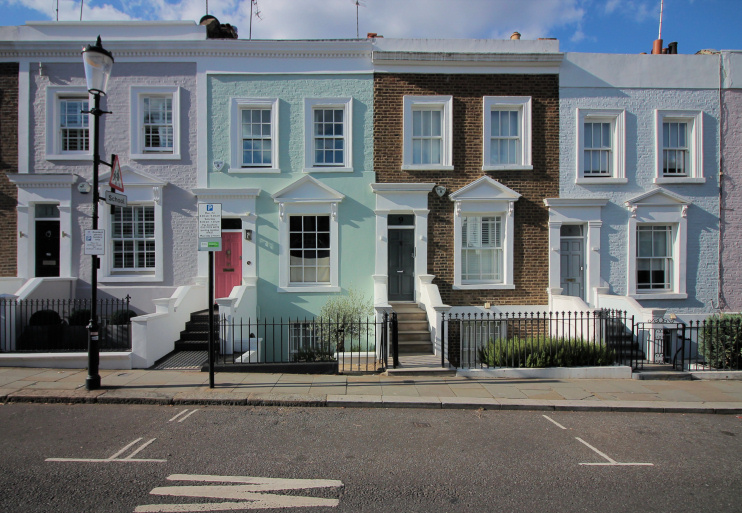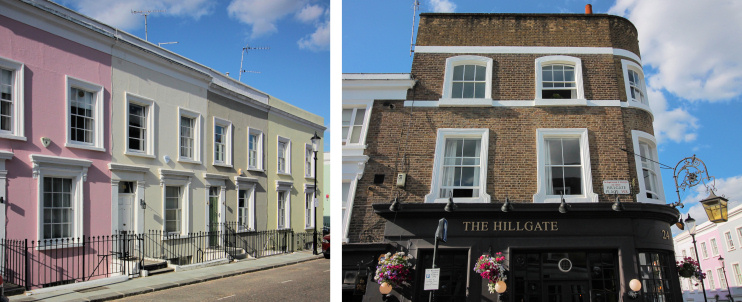Hillgate Village
Hillgate Village, Kensington & Chelsea
A compact and uniform grid of two- and three-storey brick and stucco terraces within the Kensington conservation area, situated just south-west of Notting Hill Gate station

This was the northern half (or, more precisely, two-fifths) of the area once known as the Racks, part of the Campden House estate, which came into the possession of the Phillimore family during the 18th century. In 1808 Joseph Phillimore sold this part of the Racks to John Jones of Harley Street, who two years later sold it on to John Johnson of Horseferry Road, Westminster, at what appears to have been a slight loss.
Johnson was a prosperous building contractor, working mainly with stone that he quarried on Dartmoor. Here in Kensington he used most of his land as a brickfield, while encouraging speculative building around the perimeter. Few houses were at first built – and most of those that were have not survived.
What is now Hillgate Village was almost entirely constructed in the decade after 1850, when Johnson’s son William began granting a succession of building leases. Dozens of different contractors were involved, most of them building only a few houses each. Two Baptist chapels were included: one on Kensington Place that was known for a while as the Labourers’ Church and one on what is now Hillgate Street where the congregation apparently adhered to the strictest strand of Calvinism.
Since they were first laid out, almost all the streets of Hillgate Village have been renamed. The changes are as follows:
- Campden Hill Road was Plough Lane
- Farm Place was Ernest Street
- Callcott Street was William Street
- Hillgate Street was Johnson Street (so the locality could have been Johnson Village)
- Farmer Street was Farm Street
- Jameson Street was St James or James Street
- Hillgate Place was Dartmoor Street
The evidence of the 1861 census suggests that the majority of houses were multi-occupied as soon as they were finished. Several houses contained more than 20 people – and 32 seem to have lived in one property on St James Street, spread among six households.
The occupations of the heads of households in Ernest Street included a baker, blacksmith, boot and shoe maker, breeches-maker and bricklayer, as well as a carman, carpenter, coachman and cordwainer.
The development was approximately rectangular but the original properties in the north-east corner have all been replaced, primarily as a consequence of the construction of Notting Hill Gate station in 1868.
One observer in the 1870s described Johnson Street as “a dingy, ill-favoured slum.” The neighbourhood’s poor reputation endured for almost another century but the Survey of London’s Northern Kensington volume, published in 1973, spoke of the remarkable “upward social transformation which has taken place in recent years … its most obvious outward manifestation being the liberal application of paint in various pastel shades to the brickwork of the houses.” The survey made no mention of the locality’s modern name – and nor did any other printed work at that time. However, a decade later property correspondents were regularly reporting on “the attractive mid-Victorian terraced houses in much favoured ‘Hillgate Village’ … close to Notting Hill.”
Kensington & Chelsea council has since designated Hillgate Village a ‘character area’ – covering roughly the area shown in the map below (except on narrow screens) – noting its “dense urban grain and uniform layout of [mainly] two storey terraced streets clearly distinct from the adjacent district centre.” The village has one strikingly modern house – at 23 Kensington Place. This three-bedroomed property (offered for sale at £3,650,000 in 2014) has been grade II listed for its architectural quality, for which Tom Kay was responsible.

The village pub is The Hillgate, at 24 Hillgate Street. On Farmer Street, Geale’s restaurant has been serving fish and chips since 1939. There’s a choice of champagnes on the wine lists at both establishments, as one would expect here.
PD James was the first writer to use the locality’s modern name in a literary work – in her 1986 mystery novel A Taste for Death: “His folk used to live in Hillgate Village in the old days. Proper little slum it was, when his granddad was alive. A hundred and sixty thousand they’re asking for the houses now.”
Postal district: W8
Website: Hillgate Village Residents’ Association
Bing bird’s eye view: Hillgate Village
